Exploring Aquaponics: A Sustainable Growing Method
Aquaponics is an innovative agricultural system that combines aquaculture (raising fish) with hydroponics (growing plants in water without soil) into a symbiotic environment. This method utilizes the waste produced by aquatic animals to provide organic nutrients for the plants. In turn, the plants help filter and purify the water, which is returned to the fish tanks. This harmonious relationship not only maximizes resource efficiency but also creates an eco-friendly food production system that can be implemented in urban settings, greenhouses, and backyards.
Difference Between Hydroponics and Aquaponics
While hydroponics and aquaponics share similarities in that they both involve growing plants without soil in nutrient-rich water, there are key differences that set them apart:
Nutrient Source
Hydroponics: Nutrients are provided through commercial fertilizers mixed into the water. Growers must regularly monitor and adjust nutrient levels.
Aquaponics: Nutrients come from fish waste, which contains ammonia that is converted by beneficial bacteria into nitrates—an essential nutrient for plants. This eliminates the need for artificial fertilizers.
Ecosystem Dynamics:
Hydroponics: The system is focused solely on plant growth. It does not involve any animal husbandry, which means the management of nutrients relies purely on human intervention.

